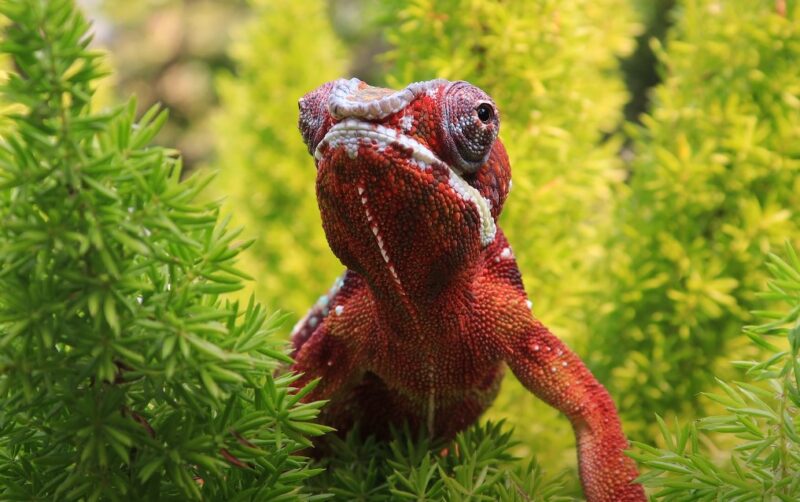Have you ever seen an animal with red fur or just their body?
Think about the animals that have beautiful red colour on their body, can you?
It’s kind of strange to think about it because they rarely anywhere to be found in our daily life. Let’s just imagine
these beautiful creatures with the bright vibrant red colour. They must be cute and pretty!
Beautiful Red Animals
Here are 32 beautiful red animals that you’ve might not know!
1. Red Panda
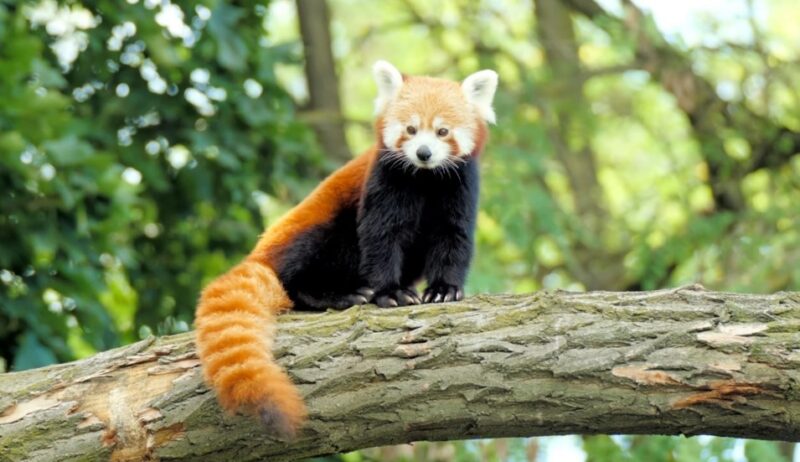
This panda is not the basic black and white panda that you’ve seen regularly. This panda has a red colour on their fur!
This cute small creature has the size around the cat that you have in your house, they are originally from southwestern China and eastern mountain ranges.
- Appearance: Red pandas have dense reddish-brown fur with a black belly and legs. Their faces are white with reddish-brown “tear” marks that extend from the eyes to the corners of the mouth, which may help keep the sun out of their eyes. They also have large, round heads, short snouts, and big, pointed ears. Their tails have alternating red and buff rings.
- Size: Red pandas are slightly larger than a domestic cat. Their body length ranges from 51 to 63.5 cm (20 to 25 inches), with long, furry tails that add about 30 to 50 cm (12 to 20 inches) in length.
- Diet: Although classified as carnivores, red pandas primarily consume bamboo. They also eat fruits, berries, acorns, flowers, and eggs, making them mostly herbivorous in their dietary habits.
- Behavior: Red pandas are mostly solitary animals and are nocturnal, meaning they are mainly active during the night. They prefer to live alone except during mating season or when females are raising their young.
- Habitat: Red pandas are adapted to life in the trees. They are arboreal and have sharp claws to help them climb. They are native to the temperate forests of the Himalayas, including parts of China, Nepal, and Bhutan.
2. Siamese Fighting Fish
You may know this bright beautiful animal as betta fish fight and you may find this species in the aquarium store. This fish is well-known in Asia such as Laos, Thailand, Vietnam and Cambodia.
- Highly Territorial: Male Siamese Fighting Fish are known for their aggressive and territorial nature. They will often fight with other males if kept in the same tank, leading to the name “fighting fish.”
- Colorful and Varied Appearance: These fish are popular for their bright and varied colors. They can display a wide range of colors including red, blue, green, and purple, often with striking patterns and iridescence.
- Labyrinth Organ: Betta fish possess a specialized labyrinth organ that allows them to breathe atmospheric air. This adaptation helps them survive in low-oxygen environments such as shallow ponds and rice paddies.
- Fin Displays and Body Posture: When threatened or during courtship, Siamese Fighting Fish will display an array of behaviors including extending their gill covers, spreading their fins, and intensifying their body color to appear more intimidating or attractive.
- Streamlined Body Shape: Their body shape is designed for smooth and effortless movement through water. They have overlapping scales that provide protection and aid in their movement.
3. Scarlet Macaw
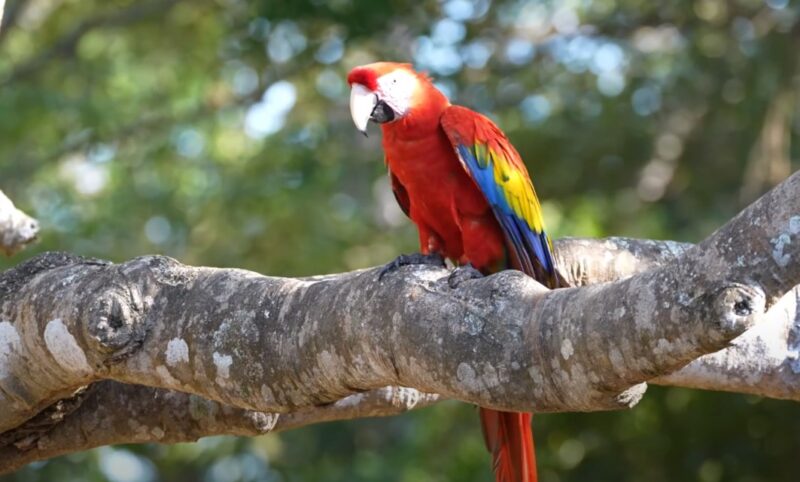
The origin of this colourful macaw bird is from South America, this huge saves still related to the neotropical parrots. However, their population is decreasing due to the environment changes.
- Bright Red Plumage: The Scarlet Macaw has bright red feathers covering most of its body, wings, and long tail, with some yellow and blue on its wings.
- Diet: These birds are herbivores, primarily eating nuts, fruits, and seeds, including some large and hard seeds (source: Animalia.bio).
- Physical Appearance: The Scarlet Macaw is known for its beautiful and colorful appearance. It has a creamy white, almost featherless face, and a strong, large bill.
- Personality: The Scarlet Macaw is described as a “sassy” bird, filled with energy and personality. It is highly intelligent and a capable escape artist.
- Habitat: The Scarlet Macaw is native to humid evergreen forests of the Americas, particularly in Neotropical regions.
4. Strawberry Poison Frog
The name of this creature might be cute but you have to be careful because they’re actually are poisonous!
This frog has black dots on their bright red body, that’s why it called strawberry. They originally are from Costa Rica and northwestern Panama. Well, you may find them around ranches.
- Coloration: The Strawberry Poison Frog is known for its vibrant and varied coloration, which includes reds, blues, and blacks. There are approximately 15-30 different color morphs of this species.
- Toxicity: These frogs are highly toxic, with skin secretions that contain potent toxins. These toxins can affect the heart and neurological system of their predators, causing convulsions and potentially death.
- Parental Care: The Strawberry Poison Frog exhibits dual parental care. Males defend and water the nests, while females feed the tadpoles with unfertilized eggs.
- Behavior: These frogs are diurnal and particularly active during the morning. They are mainly solitary and come together only to breed or compete for territory.
- Habitat: Strawberry Poison Frogs are commonly found in humid lowlands and premontane forests. They are also found in disturbed areas such as plantations.
5. Red Lory
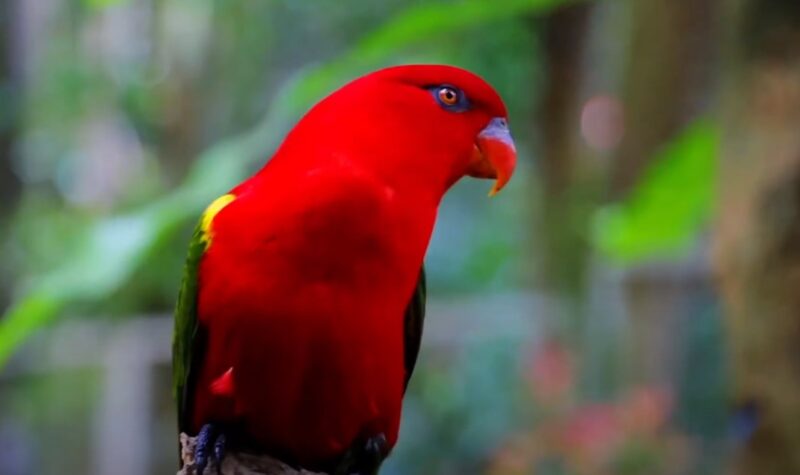
This beautiful bird is still in the parrot family. They are originally from Indonesia, New Guinea and Australia. However, this bird is the second commonly preserve in their family after rainbow lorikeet.
- Appearance: The Red Lory is a striking bird with vibrant red plumage covering its entire body. It typically measures about 31 cm (12 inches) in length and weighs between 30 to 300 grams. They have an orange beak and unique brush-like tongue.
- Personality: Red Lories are known for their playful, outgoing, and cheerful nature. They are mischievous, entertaining their owners with clownish antics and lively behavior. They are also highly intelligent birds.
- Vocalizations: These birds are vocal and can produce a variety of sounds, including short, distinctly nasal screeches and high-pitched staccato calls. They are capable of mimicking sounds and human speech to some extent.
- Habitat: In the wild, Red Lories inhabit tropical and subtropical forests, often found in Indonesia and surrounding islands. They are adaptable and can thrive in various forested environments.
- Diet: Red Lories primarily feed on nectar, pollen, fruits, and flowers. They require a specialized diet to maintain their health, which includes a mix of commercial lory nectar and fresh fruits.
6. Red-Veined Darter
This gorgeous dragonfly is still the part of Sympetrum, you may found them flying around the water or sometimes in the sea. They commonly found in the Mediterranean Island or in south-western Asia.
- Body Shape: The Red-Veined Darter has a squat, spider-like body shape, with a rounded back to the head and eyes that stick out to the sides.
- Coloration: Males have a distinctly red abdomen, which is redder than many other Sympetrum species. The wings feature red veins, and the wing bases of the hind-wings are yellow.
- Eyes: The underside of the eyes in females is blue/grey, and they have black and yellow legs.
- Pterostigma: The pterostigma (a thickened, colored cell on the leading edge of the wings) is pale with a border of black veins.
- Territorial Behavior: The Red-Veined Darter is a territorial insect, with males often seen sitting on an exposed perch.
7. Scarlet Ibis
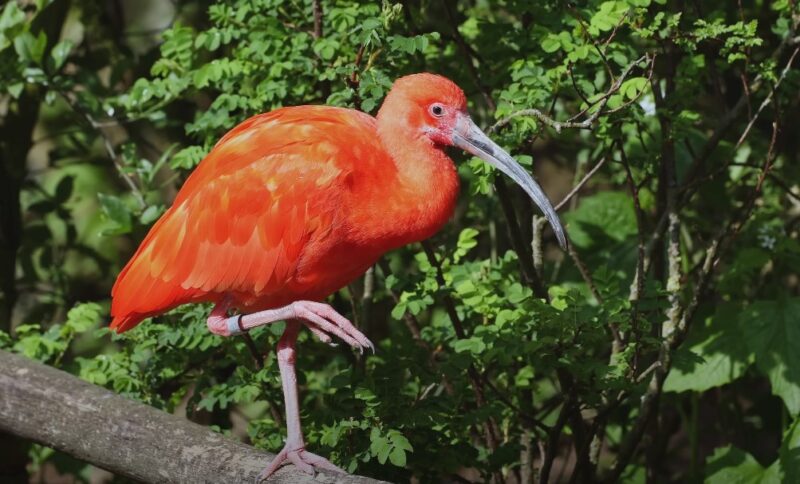
If you have heard the scarlet ibis short story written by James Hurst, then this is the actual bird you’re looking for!
This beautiful scarlet ibis is from South America and the island of Carribean. This is the bird of the national birds of Tobago and Trinidad.
- Coloration: The Scarlet Ibis is known for its vibrant scarlet plumage. Adults are entirely bright red except for their black-tipped wings.
- Bill and Neck: The bird has a long, thin, downward-curved bill and a long, slender neck, which are adapted for probing mudflats, shallow water, and grasses in search of food.
- Legs and Feet: It has long legs that are pink in color with partially webbed toes, aiding in wading through water.
- Size and Weight: The Scarlet Ibis typically weighs around 1.2 to 1.5 kilograms (2.6 to 3.3 pounds).
- Behavior: This species is sociable and gregarious, often seen in large flocks. They are also communally-minded regarding the search for food and the protection of their young.
8. Christmas Island Red Crab
This red crabby is originally from Christmas Island and the Indian Ocean, they are well-known as the crab who lay their eggs annually in the sea.
- Bright Red Color: The Christmas Island Red Crab is well-known for its striking bright red color.
- Annual Migration: These crabs are famous for their spectacular annual migration to the sea for breeding.
- Habitat: They primarily live in solitary burrows in the rainforest and are sensitive to a lack of moisture, rarely leaving their burrows during the dry season.
- Diet: They are omnivorous scavengers, feeding on fallen leaves, fruits, flowers, seedlings, human rubbish, and occasionally the giant African land snail.
- Endemic Species: The Christmas Island Red Crab is endemic to Christmas Island and Cocos (Keeling) Islands in the Indian Ocean.
9. Glass Eye Squirrel Fish
You may find this fish in the tropical sea around the world and also their size of this fish is around 50 cm.
- Large Eyes: The Glass Eye Squirrel Fish has very large eyes, which help it to see in low-light conditions, particularly at night.
- Coloration: It is typically red in color and becomes brighter as it ages. The juvenile fish are covered in brown to red patches.
- Nocturnal: This species is largely nocturnal, using its large eyes to hunt in the cover of darkness.
- Habitat: It is commonly found in reef environments and may require a dimly-lit aquarium if kept in captivity.
- Diet: The Glass Eye Squirrel Fish feeds on various small marine organisms, including serpent stars, snails, worms, and crustaceans.
10. Lady Red Bug
Yes, this red-coloured queen ladybug is just the pretty red bug! It is commonly mistaken for Asian lady beetle.
- Shape and Size: Ladybugs have oval, dome-shaped bodies with six short legs. They are generally small and round to oval in shape.
- Coloration: Many species of ladybugs are red or orange with black spots. However, some can be black with red markings or have no spots at all.
- Markings: Depending on the species, ladybugs can have spots, stripes, or no markings at all. The number and pattern of spots can vary significantly.
- Head: Ladybugs often have a black head with white patches on either side.
- Elytra (Wing Covers): The elytra of ladybugs are typically shiny and contrastingly colored, providing a distinctive and recognizable appearance.
11. Axolotl Calisto
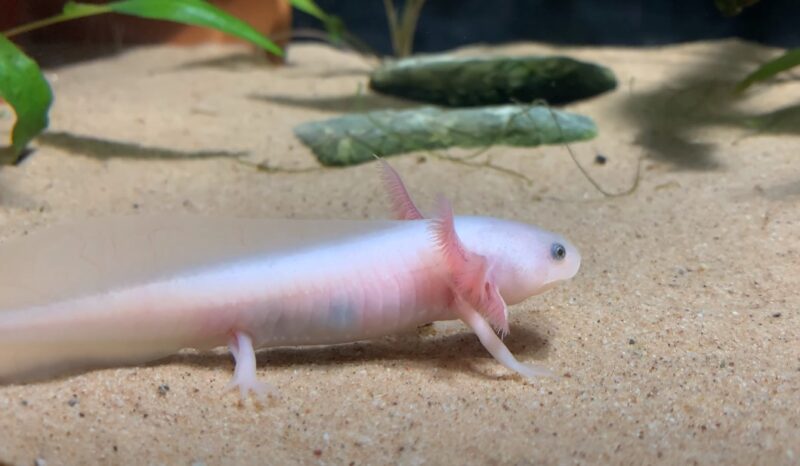
This cutie red creature can be found in Mexico. Some of the countries like Japan and America have considered this creature as a family pet! People like this animal because its face looks cute and happy.
- Regenerative Abilities: Axolotls are known for their incredible ability to regenerate lost body parts, including limbs, spinal cord, heart, and other organs.
- Neotenic Traits: Unlike other amphibians, axolotls retain their larval features throughout their lives, including gills and a finned tail.
- Color Variations: Axolotls come in various colors, including wild-type (brown/tan with gold speckles), leucistic (pale pink with black eyes), albino (golden), and melanoid (all black).
- Aquatic Lifestyle: Axolotls are fully aquatic and prefer to live in freshwater environments, primarily in lakes and canals.
- Conservation Status: Axolotls are critically endangered in the wild due to habitat destruction and pollution but are commonly bred in captivity for research and as pets.
12. Fulvous Forest Skimmer
This gorgeous red dragonfly creature can be found in India.
- Coloration: The male Fulvous Forest Skimmer is reddish-brown, while the female is paler brown. Both have transparent wing tips.
- Size: This species is a medium-sized dragonfly.
- Wing Characteristics: The wings are broadly dark reddish-brown from the base, with a scalloped or wavy outer edge.
- Habitat: They are commonly found at the edges of forests, near drains, ponds, and other water bodies.
- Abdomen: The abdomen of the males is reddish-brown, whereas the females have a paler or rusty brown abdomen.
13. Baronet Euthalia Nais
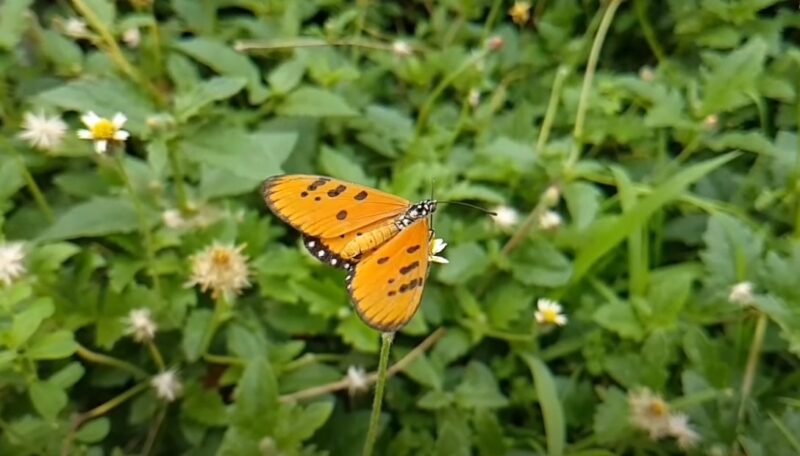
This butterfly is also from India and other South Asian Country.
14. Question Mark Butterfly
Yes, this is the butterfly with the question mark shaped “?”, you may find this red-coloured creature in North America!
- Wing Appearance: The upperside of the wings is red-orange with black spots. The forewings are hooked, and the hindwings vary seasonally in coloration and tail length.
- Wing Margins: The Question Mark Butterfly has sharply angled wing margins with short tails. The winter form has longer, violet-tipped tails, while the summer form’s tails are shorter and mostly black.
- Underside Markings: The underside of the wings is light brown and features a small, pearly-white question mark-shaped marking in the center of the hindwings, which gives the butterfly its name.
- Habitat: This butterfly is commonly found in wooded areas, city parks, and suburbs. It is often spotted in environments where it can camouflage effectively among dead leaves.
- Size: The wingspan of the Question Mark Butterfly ranges from about 5.2 to 6.4 cm.
15. Western Scorpion Fish
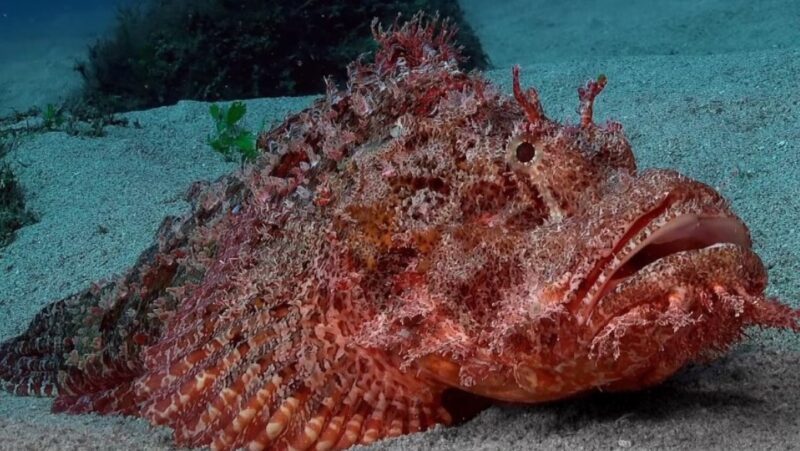
This strange fish can be found near Japan, their size is around 70 centimetres.
- Coloration and Camouflage: The Western Scorpionfish, also known as Scorpaena sumptuosa, is predominantly reddish-brown with intricate patterns of darker blotches and lighter speckles. This coloration provides effective camouflage among the reef environment.
- Sexual Dimorphism: This species is sexually dimorphic. Only the males have a black blotch on the spiny part of the dorsal fin.
- Habitat: The Western Scorpionfish inhabits coral and rocky reefs, predominantly in temperate waters of the Indian and South Pacific Oceans.
- Feeding Habits: It is a sit-and-wait predator, often lying quietly on the bottom and blending closely with its surroundings to ambush prey.
- Body Structure: The Western Red Scorpionfish has a deeper body and a more pronounced groove on the head behind the eyes compared to other southern Australian species of Scorpaena.
16. Red Tabby Cat
This adorable cat has the red accent on their fur and has a shape of “M” in their temple.
- Distinctive Coloring: Red Tabby Cats, often called orange, ginger, or marmalade, are known for their vibrant coat colors, ranging from a deep red to a pale cream. They always have a tabby pattern, which can include stripes, swirls, or spots.
- Common Gender Distribution: The majority of red tabby cats are male. This is due to the genetics of their coat color, which is linked to the X chromosome.
- Personality Traits: Red tabby cats are known for their outgoing and assertive personalities. They tend to be friendly, active, and enjoy being in the middle of family activities. They often exhibit less inhibition compared to other cats, making them more sociable and interactive.
- Intelligence and Affection: These cats are typically intelligent and affectionate. They are known to be vocal and can be quite demanding of attention, often forming strong bonds with their human companions.
- Activity Level: Red tabby cats are generally very active. They enjoy playtime and exploration, which makes them well-suited for households that can provide ample stimulation and engagement.
17. Scarlet Lily Beetle
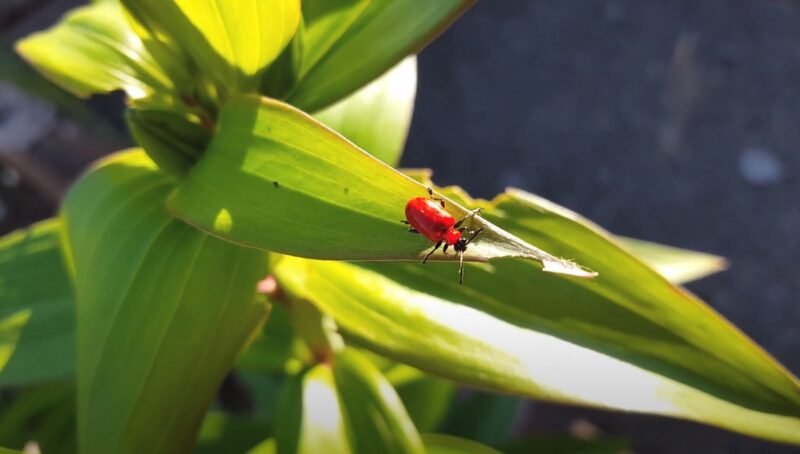
This lily fallen leaves red beetle, this beetle usually eats leaves and they consider as a parasite for some plants.
- Appearance: The Scarlet Lily Beetle has a bright red body with a black underside, head, antennae, and legs. Adults are about 1/4 to 1/2 inch long.
- Behavior: When disturbed, they can produce a chirping or squeaking sound.
- Habitat: This beetle is commonly found on lilies and feeds on their leaves, stems, buds, and flowers.
- Pest Status: It is considered a significant pest for lilies grown in gardens, often causing severe damage to the plants.
- Size: The beetle is approximately 10 mm in length.
18. Purus Red Howler
The fun fact about this monkey is that they can move until five kilometres even the heavy pouring rain in the forest.
- Physical Appearance: They have thick, dark red to brownish-red fur with bright orange or gold underparts. The face is dark and naked, surrounded by fur.
- Vocalization: Purus Red Howlers are known for their loud calls, which are facilitated by their enlarged voice boxes. These calls can be heard over considerable distances and serve as a means of communication among group members and to mark territory.
- Social Structure: These monkeys live in groups typically led by a dominant older male. Group sizes can range from 5 to 40 individuals, including several adults and sub-adults.
- Habitat: They are native to tropical lowland rainforests, often found in riverine floodplain forests. Their distribution includes areas in Brazil, Peru, and northern Bolivia.
- Diet: The Purus Red Howler monkey primarily feeds on leaves, fruits, and flowers. Their diet requires them to have a large gut capable of fermenting tough plant material.
19. Red Swamp Crayfish
Although this is one of the family aquarium pets, this crayfish is a pest. They are usually found in warm freshwater.
- Appearance: They are dark red in color with bright red raised spots on their body and claws, resembling small lobsters. They have elongated claws and a bony exoskeleton. The underside of their tail has a thick black stripe.
- Size: They can grow up to 5-13 cm (approximately 2-5 inches) long.
- Habitat and Behavior: Red swamp crayfish are known for their burrowing activities, which can cause bank destabilization and increased water turbidity. They exhibit two types of behaviors: a wandering phase with high-speed movement and an immobile stage.
- Diet: They are omnivorous, feeding on aquatic plants, snails, insects, fish, amphibian eggs, and young amphibians.
- Reproductive Cycles: The adult Red Swamp Crayfish exhibits cyclic dimorphism, alternating between sexually active and inactive periods.
20. Coconut Octopus
This red octopus is from western Pacific sea. The strange fact about this octopus is that they usually walk with two legs holding a coconut.
- Habitat: The Coconut Octopus prefers shallow coastal waters and mostly inhabits sandy or muddy seafloors. It is frequently found in bays and lagoons.
- Behavior: This species is solitary, living alone throughout its life. It is active throughout the day but focuses its hunting efforts mainly at night.
- Appearance: One of the most distinctive features of the Coconut Octopus is its suckers, which are almost white and stand out when the octopus assumes a darker coloration.
- Intelligence: The Coconut Octopus is known for its intelligence, including using tools. It often uses coconut shells and seashells for protection, carrying them along the seafloor and using them as shelters.
- Size: It is a medium-sized cephalopod, with its arms extending up to about 30 cm (12 inches) in length.
21. North Cardinal
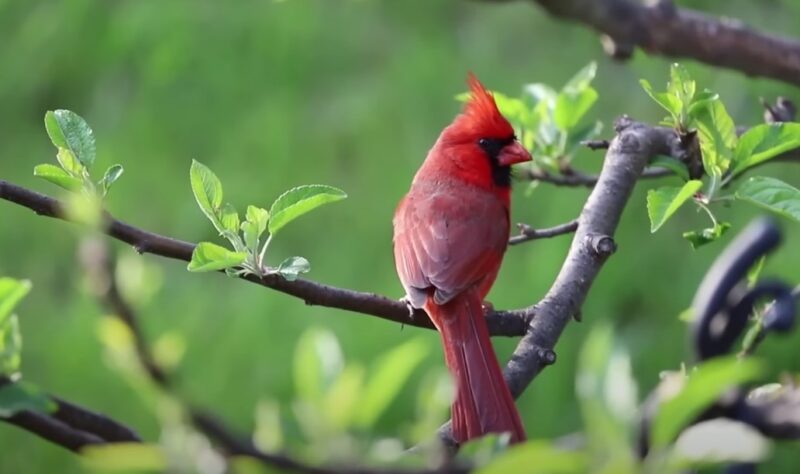
This beautiful bird is originally from North America. You may distinguish the male and female through the different colour of their feathers, the female has darker red like olive and the male has a vibrant red colour.
- Coloration: The male Northern Cardinal is known for its vibrant red plumage, which makes it easily recognizable. Females are more subdued, with brown coloring and some red accents.
- Size and Shape: Northern Cardinals are medium-sized songbirds with a length of about 8-9 inches. They have a robust, cone-shaped bill, a long tail, and a distinctive crest on their head.
- Diet: Cardinals are primarily granivorous, meaning they mainly eat seeds and grains. They also consume fruits and insects, especially during the breeding season.
- Behavior: Males are territorial and often mark their territory with songs. They are also known for their distinctive and melodious singing.
- Habitat: Northern Cardinals are commonly found in woodlands, gardens, shrublands, and wetlands. They are abundant in the southeastern United States but can be found throughout the eastern and central U.S.
22. Eastern Red-Spotted Newt
This amphibian is from Eastern North America, this one usually becomes the family pet.
- Coloration: Adults have an olive green to yellow-brown dorsum with pale to yellow bellies covered in black dots. They also have a row of black-bordered red spots on their backs.
- Life Stages: They go through several life stages, including the aquatic larval stage, terrestrial juvenile stage (known as the “red eft”), and the aquatic adult stage.
- Toxic Skin Secretions: These newts have slightly moist skin that secretes toxins, which deter predators.
- Habitat: Adults inhabit permanent water bodies like ponds, marshes, and shallow lakes, while the terrestrial efts are found in moist forested areas.
- Breeding Season Features: During the breeding season, males develop black, rough patches on the inside of their thighs and the bottom tips of their hind toes.
23. Red Velvet Ant
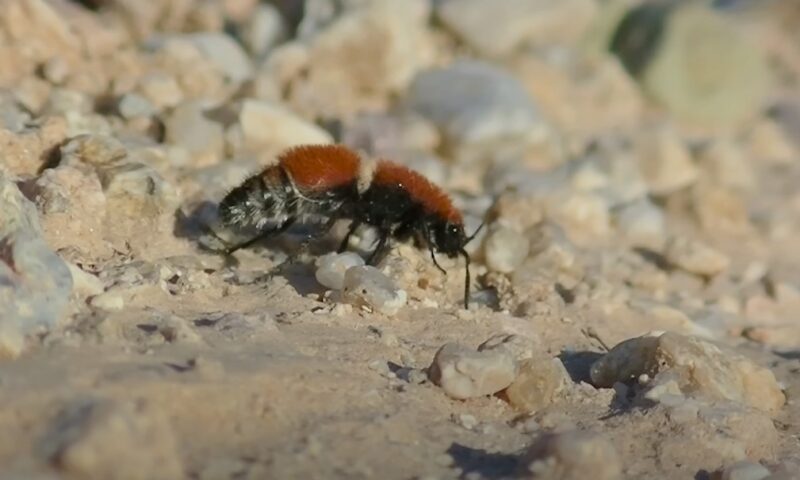
This wasp species is from Eastern America. This ant is huge and because their size can be about 2 cm, the female and can sting the cow.
- Appearance: The females are wingless and covered with dense hair, giving them a superficial resemblance to ants. They are known for their bright red or orange coloration and are the largest velvet ant species, reaching about 3/4 inch in length.
- Habitat: Red velvet ants are widespread throughout the eastern United States. They are commonly found in dry, open areas such as sidewalks and sunny lawns, as well as meadows, clover fields, forest edges, and deserts.
- Sting: These insects possess a powerful sting, which has earned them the nickname “cow killer.” The sting is very painful but not deadly.
- Sexual Dimorphism: Red velvet ants are a sexually dimorphic species, meaning there are distinct differences in appearance between males and females. Males have wings, while females do not.
- Durable Body: They have a tough, durable outer body that is difficult to pierce or break, providing them with protection from predators.
24. Tschudi’s False Coral Snake
This snake is also called as Oxhyropus Melanogenys. Their size is around until 68 centimetres long. They originally are from South America.
- Appearance: Tschudi’s False Coral Snake is a medium-sized snake, moderately slender, with a medium to moderately long, slender, and gradually tapering tail. It can grow to a maximum length of about 1.08 meters.
- Coloration: This snake mimics the coloration of venomous coral snakes, featuring bands of red, black, and white or yellow. This mimicry helps protect it from predators.
- Distribution: Tschudi’s False Coral Snake is found in the northern part of South America, including countries such as Peru, Ecuador, and Colombia.
- Behavior: Despite its venomous appearance, Tschudi’s False Coral Snake is harmless. It relies on its mimicry of the more dangerous coral snakes to deter predators.
- Habitat: This species typically inhabits tropical rainforests and other humid environments where it can find cover and prey.
25. Tomato Frog
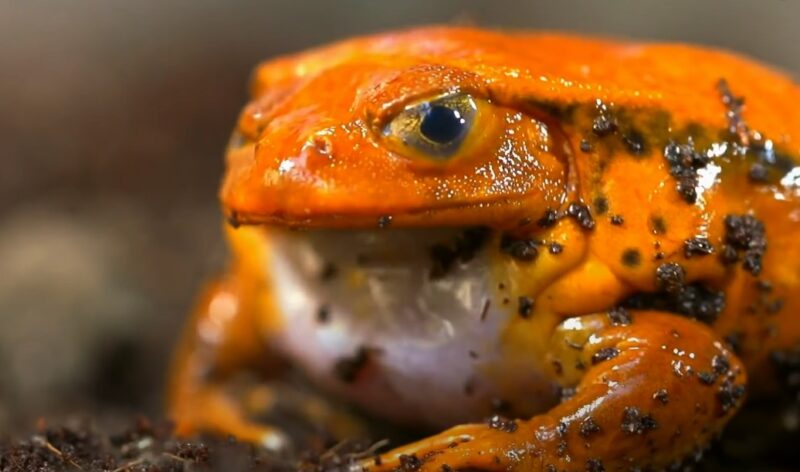
This red tomato can expand their size when they feel endanger and they would splash the poison out from their body to kill the predator.
- Habitat: They are found in Northeastern Madagascar, inhabiting rainforests, coastal forests, scrubs, and even urban areas.
- Behavior: Tomato frogs are ambush predators, meaning they wait for prey to come near before attacking.
- Adaptations: They do not have webbed hind legs, making them poor swimmers. They prefer calm or almost stagnant water habitats.
26. Mwanza Flat-Headed Rock Agama
This spiderman agama is from Tanzania, Kenya, and Rwanda. They usually live in the desert hiding between the rocks.
- Vibrant Coloration: The male Mwanza Flat-Headed Rock Agama has a bright red or violet head, neck, and shoulders, while the body is dark blue. Females are mostly brown and less colorful.
- Habitat: It lives in semi-deserts and is often seen basking on rocks or kopjes during the heat of the day.
- Diet: This species is insectivorous, feeding primarily on insects such as locusts, crickets, mealworms, and waxworms.
- Behavior: They can run on only their hind legs when necessary, displaying remarkable agility and speed.
- Size and Physical Features: They have a large head separated from the body, a long tail, well-developed external ear openings, and eyelids. The males are especially noted for their striking coloration and distinctive body shape.
27. Red Squirrel
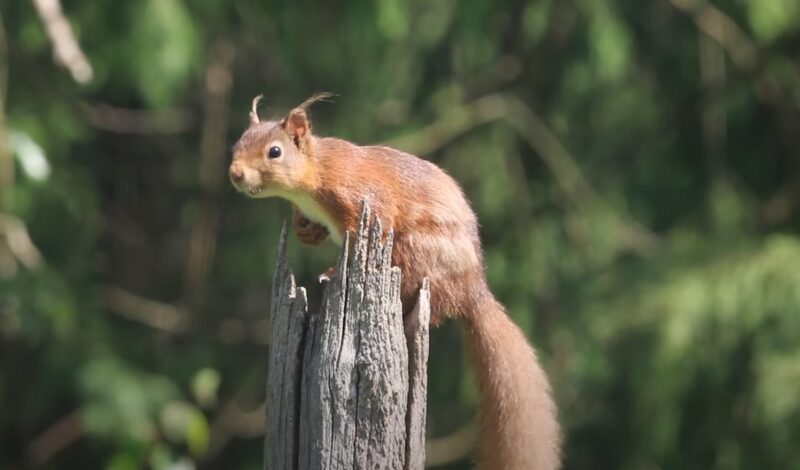
This squirrel is from Eurasia, they live in trees of the warm forest in around Europe or Siberia.
- Fur Color: Red squirrels are known for their striking orange-red fur. However, their color can vary and include shades from wheaten through ginger to darker brown.
- Tail and Eye Ring: They have a bushy tail that is dark red with hints of other colors and a distinctive eye ring.
- Diet: Red squirrels are primarily herbivorous, eating acorns, hazelnuts, seeds from deciduous trees, shoots, berries, fruit, and occasionally bird eggs.
- Physical Adaptations: They have sharp curved claws that help them climb and descend tree trunks, branches, and even house walls. Their strong hind legs assist in agile movements through the trees.
- Size: An average red squirrel measures 11 to 13 inches in length, including the tail. They are smaller and lighter compared to the more common grey squirrel.
28. Red-Headed Cardinal Beetle
The fun fact about this beetle is the bright red colour is to undercover them to look like they are poison to some of the predators. You may see them in the UK with the size around 2 centimetres.
- Bright Red Coloration: The Red-Headed Cardinal Beetle is notable for its bright red head and wing cases (elytra). This vibrant coloration helps it stand out and may serve as a warning to predators.
- Black Legs and Antennae: It has black legs and long, black, toothed antennae, which contrast sharply with its red body.
- Medium Size: The beetle is medium-sized, typically measuring between 10-18mm in length.
- Habitat: It is commonly found in woodland edges and on flowers where it hunts small insects and feeds on pollen.
- Distinctive Head Color: Unlike other cardinal beetle species that may have black heads, the Red-Headed Cardinal Beetle is distinguished by its red head.
29. Cherry Shrimp
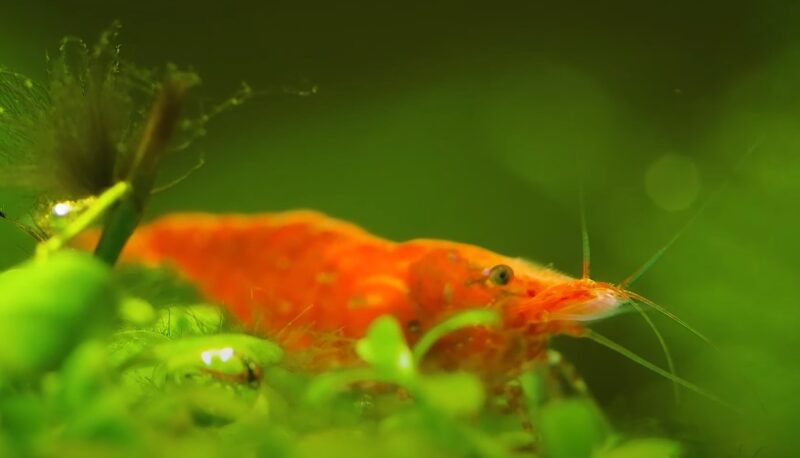
The size of this shrimp can be reached until 4 centimetres, however, the bright red colour you see is actually from the aquarium, the original colour of this shrimp is green and brown.
- Peaceful Nature: Cherry Shrimp are very peaceful and will not harm any tankmates, but they are vulnerable and can easily fall prey to other creatures.
- Distinct Rostrum: The rostrum (beak) of the Cherry Shrimp has a squared shape, which differentiates it from the more pointed shape of saltwater shrimp species.
- Sexual Maturity and Reproduction: Cherry Shrimp reach sexual maturity and can reproduce at about 30 days of age.
- Color Variations: There are various grades of Cherry Shrimp, ranging from deep dark red to paler colors. Females are typically more colorful and sensitive to color changes.
- Beginner-Friendly Pets: Cherry Shrimp are low-maintenance and great pets for beginners, providing a good introduction to keeping aquatic creatures.
30. Red Velour Mite
This mite is actually predators to some pests that you may find in the dirty water.
- Appearance: Red Velour Mites, also known as Red Velvet Mites, have a bright red coloration and velvety texture, making them easily recognizable. They are relatively large compared to other mites, with some species growing up to 1.5-2 cm in length.
- Body Structure: These mites belong to the family Trombidiidae and are arachnids, meaning they have eight legs. Their bodies are covered in fine, velvety hairs, which contribute to their distinctive appearance.
- Habitat: Red Velour Mites are commonly found in plant litter, on rocks, tree trunks, or on the ground, particularly after rain. They thrive in environments that provide ample organic material for feeding.
- Diet: As adults, Red Velour Mites are predators, feeding on small invertebrates. Their larvae, however, are parasitic and attach themselves to insects and other arthropods.
- Life Cycle: The life cycle of Red Velour Mites includes several stages: egg, larva, nymph, and adult. The larvae are typically parasitic, while the nymphs and adults are free-living predators.
31. Mediterranean Red Sea Star
The size of this sea star is about 20 centimetres long and you can find them in the East Atlantic and the Mediterranian Sea.
- Color: The Mediterranean Red Sea Star is vivid red to red-orange in color.
- Arms: It typically has five slender, cylindrical arms, though it can occasionally have four, six, or seven. These arms are connected to a small central disc.
- Size: The arms are 8 to 15 cm long, and the average arm span is 10 to 20 cm, with a maximum span of 30 cm.
- Habitat: This species thrives in various habitats, including rocky seabeds, seagrass meadows, and sandy bottoms, typically at depths ranging from 10 to 50 meters.
- Behavior: It is a scavenger, feeding on detritus and small invertebrates.
32. Blood-Red Glider
This butterfly is from Central Africa. This butterfly is also from the Nymphalidae family.
- Appearance: The Blood-Red Glider is known for its striking deep red wings, which are unique and make it easily recognizable among butterflies.
- Habitat: This species is primarily arboreal, meaning it lives mainly in the forest canopies of Central Africa.
- Diet: Blood-Red Gliders have a particular taste for rotting fruit, which they will seek out from the jungle canopy.
- Family: It belongs to the family Nymphalidae, a diverse family of butterflies commonly known as the brush-footed butterflies.
- Geographical Distribution: The Blood-Red Glider is found in Central Africa, making it a species native to this region.

